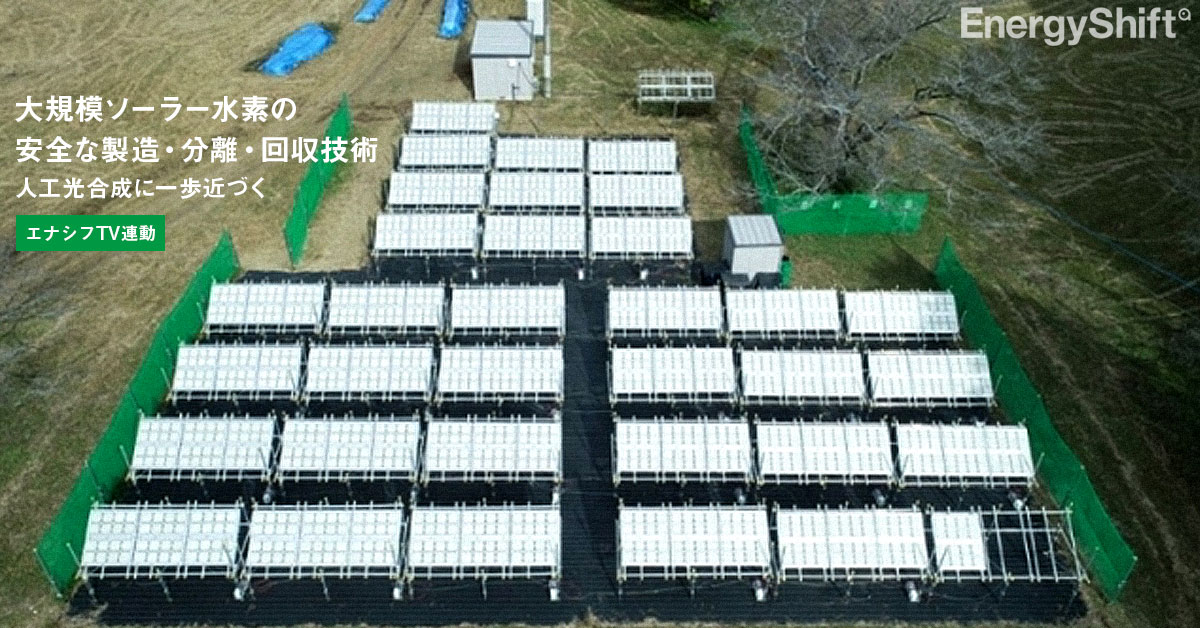
東京大:純度高い水素取り出す:「光触媒」で成功(動画):
Tokyo Univ : High-purity hydrogen extraction: with “photocatalyst”:
东京大学:高纯氢气提取:“光触媒”成功
ー「光触媒」の働き活用ー
東京大学
信州大学
NEDO
- 100平方メートルの規模で、
- 高純度の水素を安全に取り出す実験に、
- 研究チームが成功しました。
ことし8月、国際的な科学雑誌「ネイチャー」で発表しました。
大量・低コストで水素作製:
太陽の光を当てることで、水を水素と酸素に分解する「光触媒」を活用しました。
大量かつ低コストで作る技術につながる成果として期待されます。
今回の実験:
光触媒物質を付着させたパネルを使います。
パネルを屋外に設置して水を注ぎます。
- 太陽の光を受けて発生した、
- 水素と酸素が混ざった気体から、
- 穴の空いた膜を通すことで、
水素だけを抽出します。
実験の結果:
- 発生した水素の7割以上を、
- およそ94%という高純度で、
- 安全に取り出せた。
おととしから、2年ほど実施してきました。
東京大学
堂免一成特別教授こうした大規模な実験は、爆発の危険性があるため世界でも例がなかった。
- 安全に取り扱える方法を考え、装置を開発した。
- 早く実用化して、安い水素を世の中に提供したい。
光触媒とは:
光を当てると、周りの物質の化学反応を促進させる物質です。
代表的な物質としては、白い塗料や化粧品などに使われる「酸化チタン」がよく知られています。
環境 | NHKニュース
https://www3.nhk.or.jp/news/html/20211017/k10013310361000.html
世界初!日本勢がソーラー水素の安全な製造と分離・回収技術を達成 人工光合成に一歩近づく | EnergyShift
https://energy-shift.com/news/28271049-d42d-4a8f-861a-0890f9e5f6ec
Photocatalytic solar hydrogen production from water on a 100-m2 scale
The most efficient solar hydrogen production schemes,
which couple solar cells to electrolysis systems, reach solar-to-hydrogen (STH) energy conversion efficiencies of 30% at a laboratory scale3.
Photocatalytic water splitting reaches notably lower conversion efficiencies of only around 1%,
but the system design is much simpler and cheaper and more amenable to scale-up1,2
provided the moist, stoichiometric hydrogen and oxygen product mixture can be handled safely in a field environment and the hydrogen recovered.
Extending our earlier demonstration of a 1-m2 panel reactor system based on a modified, aluminium-doped strontium titanate particulate photocatalyst4,
we here report safe operation of a 100-m2 array of panel reactors over several months with autonomous recovery of hydrogen from the moist gas product mixture using a commercial polyimide membrane5.
The system, optimized for safety and durability, and remaining undamaged on intentional ignition of recovered hydrogen, reaches a maximum STH of 0.76%.
While the hydrogen production is inefficient and energy negative overall,
our findings demonstrate that safe, large-scale photocatalytic water splitting, and gas collection and separation are possible.
To make the technology economically viable and practically useful,
essential next steps are reactor and process optimization to substantially reduce costs and improve STH efficiency, photocatalyst stability and gas separation efficiency.
Nature
https://www.nature.com/articles/s41586-021-03907-3
Hydrogen extracted from water on larger scale | NHK WORLD-JAPAN News
https://www3.nhk.or.jp/nhkworld/en/news/20211017_03/